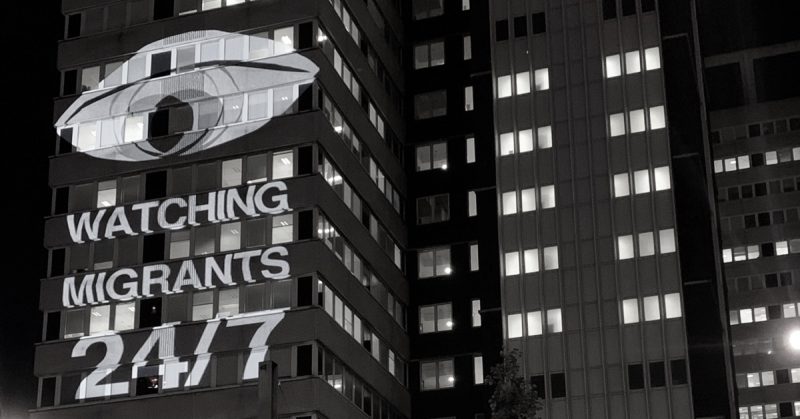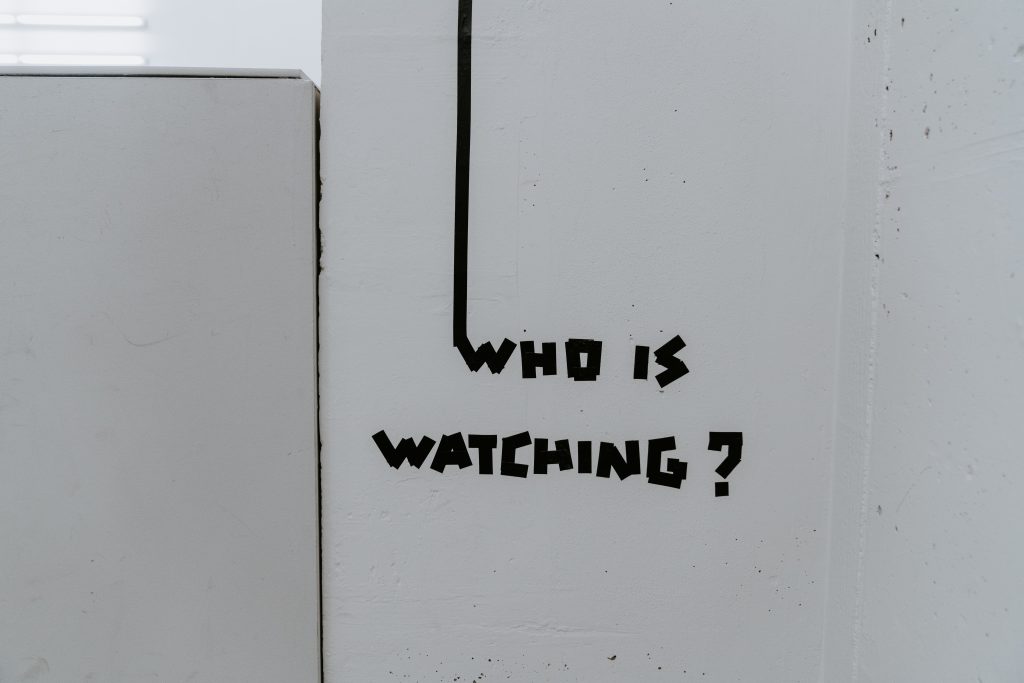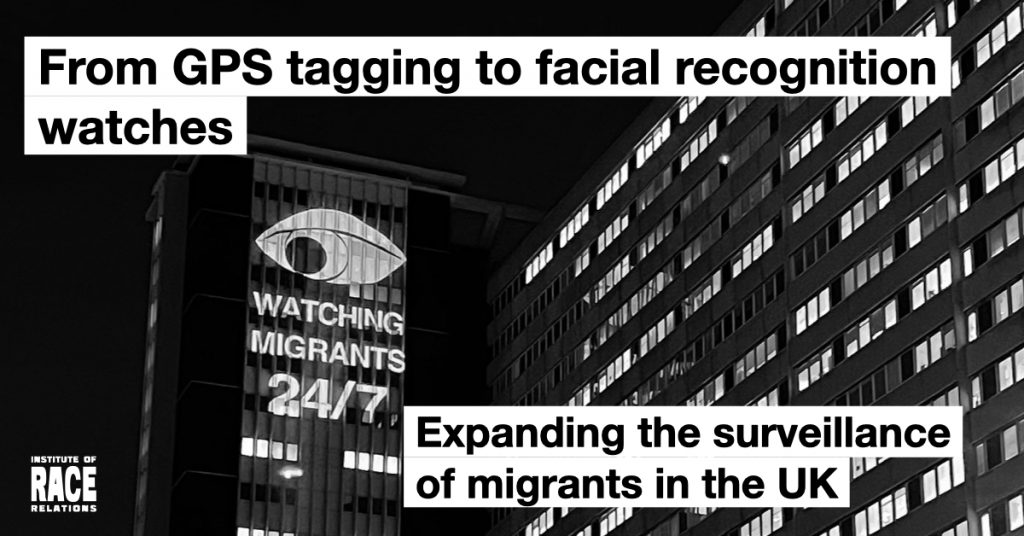Written by Lucie Audibert (Lawyer and Legal Officer, Privacy International) & Monish Bhatia (Lecturer in Criminology, Birkbeck, University of London)
Through its use of GPS tags and smartwatches in immigration enforcement, the UK is extending the reach of surveillance and control of migrants to frightening levels.
In early August, we learned that the Ministry of Justice had awarded a £6m contract for ‘facial recognition smartwatches’ to be worn by foreign national offenders. The devices will track their GPS location 24 hours a day, 7 days a week, and will require them to scan their faces up to five times a day. The information obtained from the devices, including names, date of birth, nationality, photographs, and location data, will be stored for up to six years and may be accessed by the Home Office and shared with law and border enforcement agencies.
This is just the latest intrusive electronic monitoring (EM) technology to be used on migrants, after the Home Office moved from ‘traditional’ radio frequency tags (which measure the distance between the tag and the subject’s home) to GPS tags (which monitor the subject’s precise location 24/7). Electronic monitoring has been a key part of criminal justice for many years throughout the world, operational in many US states since the 1980s and implemented in England and Wales under the Criminal Justice Act 1991. It was introduced to address prison overcrowding and the rising costs of incarceration by diverting offenders from custody, but it is doubtful whether EM actually shrinks the size of prison populations or simply expands criminal justice interventions through a ‘net-widening effect’ – a 2016 comparative study found that high use of imprisonment is linked to high use of EM.[i] England and Wales now has the highest number of offenders subjected to this technology in the world,[ii] and has extended its use to immigration enforcement, through the Asylum and Immigration (Treatment of Claimants, etc) Act 2004. (In the US, it was extended to immigration control in about 2002.) As far as we know, Britain is the only state in Europe to use EM in the migration arena.

EM is used as a condition by the Home Office for people released from immigration detention on bail, added to conditions such as reporting to the immigration authorities or staying at the property stated on the bail application, for those the Home Office considers at risk of absconding. One of the key differences in the use of EM within the criminal justice and immigration systems is time: whilst criminal sentences involving EM are determinate in nature, the immigration system uses it with no upper limit nor clear guidelines around time. Home Office guidance says tags are most likely to be used on individuals posing a ‘high risk of harm to the public’, but it is not just foreign nationals who have completed their sentences who are tagged: a 12-month pilot scheme began in June to test electronic monitoring on any asylum seekers who arrive in the UK by ‘unnecessary and dangerous’ routes.
Alternative to detention?
It is now well-known that detention centres are harmful, exacerbating mental distress and anxiety amongst those confined, leading too often to suicide and self-harm. EM has been described as an alternative to detention, and its use may seem attractive to certain anti-detention activists for humanitarian reasons. However, EM (and other alternative measures, such as signing at the reporting centres) represent a net-widening of interventions. More importantly, although tagging is not supposed to be punitive – it is an ‘administrative measure’ enforced by the Home Office and the immigration tribunal, not the criminal courts – it is experienced as punishment and deprivation of liberty by those subjected to it. Less intrusive alternatives have an equally high compliance rate: after the US Family Case Management Program (FCMP) was implemented, in which families received caseworker support without having to wear an ankle monitor, they had 99 per cent compliance with court appearances and ICE appointments. A similar pattern was noted across other initiatives where the compliance rate was 100 per cent and rate of absconding 0 per cent. And in the UK, an FOI request to the Home Office revealed that in 2019 only three percent of those released from detention without EM absconded, and only one percent in 2020. As Bail for Immigration Detainees noted, ‘With rates of absconding so low, [EM] is designed to solve a problem that does not exist.’
Mental distress
Bhatia’s research on the impact of EM on mental health[iii] revealed that migrants consider EM as punishment, triggering the feeling of perpetual confinement and the constant feeling of being watched. The individuals were not able to carry on with their daily activities and they were perceived as ‘dangerous’ (non-white) persons in public spaces. The criminalising, dehumanising and degrading effects of EM resulted in deeper exclusion and isolation, and mental distress. As one research participant explained: ‘I felt in prison with that thing [i.e. tag] . . . they came every week to check the tag. I was very upset and thinking, I keep talking to myself: “what has happened to me?”. All I did was smoke drugs, take pills at house and fall asleep. So much pressure and depression and no freedom . . . I have not done anything wrong. I just wanted life. This is shit life, this is no life. Whenever I don’t take drug, I felt like suicide.’

Total surveillance
When Bhatia did his research on the impact of EM on migrants’ mental health, monitoring of migrants relied on traditional radio frequency tags rather than GPS tags. In 2021, the Home Office introduced GPS tagging for immigration bail. While ‘traditional’ radio frequency tags merely measure the distance between the tag and a base station in the subject’s home, usually in order to enforce a curfew, GPS tags monitor subjects’ precise location 24/7, generating a considerable volume of ‘trail data’, which is stored for years. Trail data is highly sensitive – it provides deep insight into intimate details of an individual’s life, revealing a comprehensive picture of everyday habits and movements, permanent or temporary places of residence, hobbies and other activities, social relationships, political, religious or philosophical interests, health concerns, consumption patterns, etc – data that is absolutely unnecessary and disproportionate to the stated purpose of monitoring bail compliance and preventing absconding.
The Home Office can access the entire trail data every time a breach of bail conditions is detected by the tag (eg, breaching a curfew, entering an exclusion zone, or failing to charge the tag’s battery). It has also claimed the right to review trail data in order to assess tagged individuals’ claims to private and family life (a way to resist removal through human rights law). This use of trail data falls entirely outside the scope of the legislation, and arguably violates not just privacy and data protection but other rights too – the knowledge that every single movement is monitored, and may be used to justify refusal of applications, is a serious limitation on freedom of movement, assembly and association. This is why in August 2022, Privacy International filed a complaint with the UK Information Commissioner’s Office, on the grounds of breaches of data protection and human rights law.
Errors and discrimination
Tagging is operated exclusively by the private sector in England and Wales, and the EM market is highly oligopolistic, with only four or five companies bidding for lucrative government contracts. Despite the sparse or inconclusive evidence around the effectiveness of the technology, and ongoing Serious Fraud Office investigations of G4S, one of the main players in the market, the company was awarded a £22 million contract in May 2022 by the government. Serious concerns have been raised over the lack of independent oversight of the EM industry and insufficient monitoring by government bodies.
This is particularly concerning given that the technology involved in GPS tags is prone to failures and inaccuracies, leading to wrongful accusations of breach of bail conditions and inaccurate compliance records. GPS location data can be inaccurate, sometimes by 100 metres or more, depending on the surrounding environment – for example, highly built-up areas will cause a GPS signal to ‘drift’ and record inaccurate locations. In addition, the tags used by the Home Office have been reported to suffer from serious battery issues, with people reporting having to charge them multiple times a day. This is a serious problem, as battery depletion is usually deemed a breach of bail conditions – it therefore triggers an alert and entitles the Home Office to review all trail data. In addition, applications based on family and private life may be wrongfully refused on the basis of such inaccurate trail data. In August 2022, Privacy International filed a complaint with the UK’s Forensic Science Regulator about systemic failures in relation to the quality and accuracy of data extracted from the devices.
Facial recognition smartwatches are meant to be ‘less invasive’ and ‘more proportionate’ than GPS ankle tags – but in fact are likely to cause more harm to non-white people. Facial recognition is known to be a discriminatory technology that regularly misidentifies people of colour and is disproportionately used against minorities. Facial recognition algorithms are usually trained on non-representative datasets of faces, and their design is often infused with existing racial biases – meaning that non-white people are more often misidentified. This will inevitably cause additional levels of anxiety to non-white people who have to wear these, and to false allegations and excessive enforcement against them.
Fighting Back
Over 40 human rights groups condemned the introduction of GPS tags (without consultation) in June 2021, as ‘an extension of immigration detention beyond the physical walls of detention centres and prisons’. Labour MP Bell Ribeiro-Addy, vice-chair of the all-party parliamentary group on immigration detention, described 24/7 tracking via GPS tags as ‘a Trojan horse which would grant the Home Office expansive new surveillance powers which would extend well beyond their stated purpose’. A number of legal challenges have been launched, in addition to Privacy International’s complaints. As Rudy Schulkind of Bail for Immigration Detainees said, ‘This is a thoroughly dehumanising policy designed to ensure that certain people can never be allowed to enjoy a moment of peace, dignity or community.’ The race to acquire invasive surveillance technologies leads a considerable amount of public funds to line the pockets of tech companies, instead of spending these funds on support for vulnerable migrants, dealing with the backlog of immigration applications, and generally useful, respectful and lawful policies.

